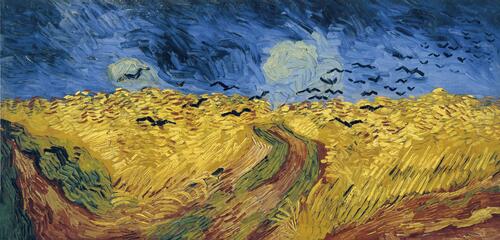
The term “Post-Impressionism” was first used in 1910 by the English art critic Roger Fry, who needed a word to describe the group of artists including Vincent Van Gogh, Paul Gauguin, Paul Cezanne, and Georges Seurat whose work he had assembled for an exhibition at the Grafton Galleries in London. While French eyes would have been more accustomed to these revolutionary artists, to English audiences, they were positively avant-garde, and Fry needed a word that wouldn’t be too radical to the ticket-buying public but would also offer a correct assessment of the artists. It turned out, however, that these artists working in the wake of Impressionism didn’t really have one shared vision or set of guiding principles that would uniformly describe their work, so the best way Fry could group them together was by saying that they came “post” (or after) Impressionism. A cop-out, perhaps, but no one can disagree with a sequence of events, and the name has stuck.
Simply stated, Post-Impressionism is a natural extension of Impressionism, borrowing certain elements but embracing more artistic possibilities than Impressionism ever did. It bloomed against the fertile backdrop of Belle Époque Paris, that is, Paris between 1871 and 1914, a prosperous and glamorous, newly modernized city in which the arts (and sciences) were flourishing. While the Academy still favored the classicized, “Academic” style characterized by invisible brushstrokes and idealized figures, Impressionism had broken with tradition so thoroughly that splintering schools of artists were able to emerge. At the same time, more and more galleries popped up to meet the elite classes’ growing demand for art. Many artists were able to find a niche for themselves among similar-minded creatives, whether painters or writers or critics. Paul Cezanne, for instance, was friends with the novelist Emile Zola, and Vincent Van Gogh, whom many imagine toiled away at his canvases in complete seclusion, actually studied in Paris in the studio of Fernand Cormon and was friends with fellow artists Henri de Toulouse-Lautrec and Emile Bernard.
The major artists from this period each worked in their own, idiosyncratic styles, expressing inner ideas, emotions, and symbolism through simplified colors and forms. Nevertheless, they shared a number of characteristics that were borrowed from the Impressionists. Like the Impressionists (and the Realists before them), the Post-Impressionists’ preferred subject matter was typically contemporary life, though their personal preoccupations on the theme varied. Some, like Toulouse-Lautrec, focused on the glamorous underbelly of Paris, while others, like Van Gogh, concentrated on peasant life in the French countryside. Like the Impressionists, the Post-Impressionists made no attempt to hide their brushstrokes. They also found inspiration in Edo-Period prints, which encouraged them to simplify space and depth.
But what really separated the Post-Impressionists from the Impressionists was the fact that they were less interested in portraying things exactly how they are seen by the naked eye (except for Seurat) and more interested in the emotional and symbolic resonance of color, form, and subject matter. In fact, it was Post-Impressionists like Paul Gauguin who pioneered the use of “arbitrary color,” which is the choice of a color that has no basis in the realistic appearance of an object but conveys a feeling or psychological state, a technique which would influence later artists like Edvard Munch, creator of The Scream, and Henri Matisse.
This adaptation of previous movements like Impressionism by the Post-Impressionists is a common theme going forward in the 20th century. Modernism in many ways is an extension of Impressionism, as Impressionism revolutionized the possibilities of painting in terms of technique, form, and subject matter, and opened the door to abstraction. Many point to Van Gogh’s painting Wheatfield with Crows as an example of what was to come. In that painting, you can see the foreshadowing of expressionism, cubism, abstract expressionism, and, if you use your imagination, maybe even minimalism. The stripping down of process and subject matter to its basic elements was and is a powerful idea that would capture the imagination of many artists to come.
Key Artists:
-
Vincent van Gogh - Visionary painter of landscapes and peasants
-
Paul Gauguin - Painter known for his images of the Pacific Islands
-
Henri de Toulouse-Lautrec - Colorful painter of the Moulin Rouge
-
Suzanne Valadon - Post-Impressionist who prefigured Expressionism
-
Georges Seurat - Post-Impressionist who invented Pointillism
-
Paul Signac - Another Post-Impressionist who worked in Pointillism
-
Henri Rousseau - Post-Impressionist and Primitive artist
-
Odilon Redon - Post-Impressionist and Symbolist artist
-
Paul Cézanne - Post-Impressionist and Father of Cubism
For additional information about this movement, see Sartle School of Art History: Post-Impressionism.
This reader is part of a larger series of introductory texts about art and art history. Each has been written under the direction of Rick Love. This reader was co-authored by Jeannette Sturman.
Comments (3)

This is my first time visiting your blog

I wonder how the post-impressionists would feel about being all lumped together when their styles varied so much.












I remember writing an essay on Expressionism, a topic that was too difficult to cover. I was only able to get a partial grasp of it in my essay.